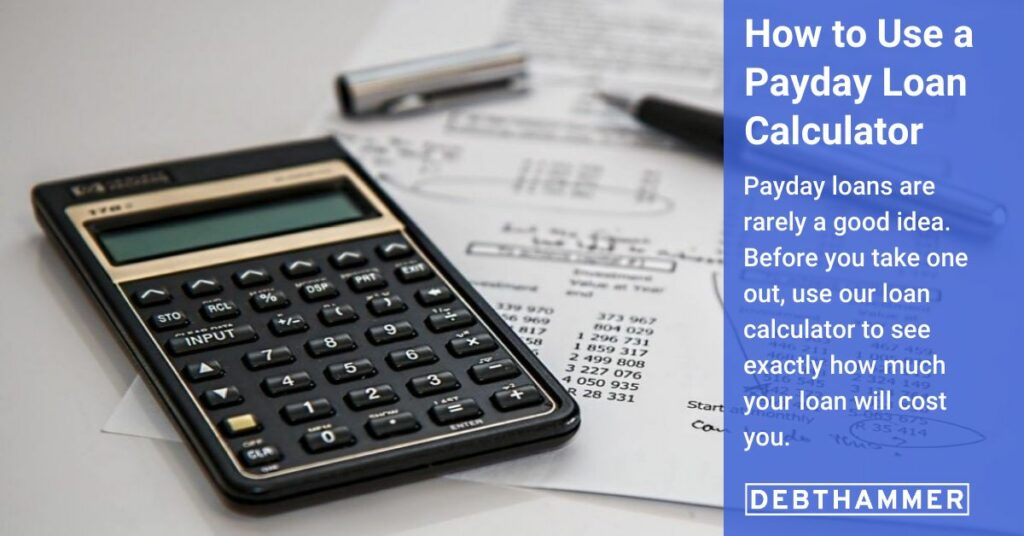Payday loans are dangerous. What looks like a small fee at first often adds up to thousands of dollars.
Before you take out a payday loan, use our pay loan calculator to determine your interest rate and compare how it stacks up against other types of loans.
Table of Contents
Calculate your payday loan APR
You can calculate the APR for your payday loan based on the fee charged, the principal amount and the loan term length.
Then, you just need to do some simple math. We’ve taken care of that part for you. Just type in your information and the calculator will do the work.
READ MORE: Payday loan interest rates
Things to keep in mind when using a payday loan calculator
- It’s just an estimate: You might have to pay more based on the conditions of the loan
- Double-check your information because the results are based on the details you provide
- Use an online loan calculator as a tool, but don’t let it be your only source of information
- Fees and rates can vary considerably based on the laws in your state
- Ask the lender if any hidden fees or fees are not mentioned upfront. Different lenders have different fees
READ MORE: Is my payday lender licensed in my state?
How payday loan interest rates are calculated
Payday loan interest rates are deceptive because they aren’t presented as interest rates. Instead, they are charged as fees. The APR for your payday loan will be based on the fee charged, the principal amount and the length of the loan term.
This example explains how the payday loan calculator breaks down your loan cost:
- You borrowed $375. The fee is $15 per $100 borrowed, so $56.25 total. You have 15 days to repay the loan.
- Divide the fees by the principal: $56.25 / $375 = 0.15
- Multiply the answer in Step 1 by the number of days in the year: 0.15 x 365 = 54.75
- Divide the answer in Step 2 by the number of days in the loan term (15): 54.75 / 15 = 3.65
- Multiply the answer in Step 3 by 100: 3.65 x 100 = 365% APR
Additional fees could increase your payday loan APR
The fee for your payday loan may not be the only fee you have to pay. Be sure to check your loan agreement for other fees that may apply.
- Rollover fee: Charged when you need to “rollover” your original payday loan to a new loan with a new repayment deadline. You will also pay a new set of borrowing fees.
- Non-Sufficient Funds fee (also sometimes called an overdraft fee): Charged when there is not enough money in your checking account to repay your debt
- Late fee: Charged if your payment isn’t made by the due date.
These fees will vary by lender and state.
READ MORE: How to get out of payday loan debt
Before you get a payday loan
If you’re considering a payday loan, you probably need cash fast and can’t afford to wait. But it’s important to make sure you know the risks.
- Can you repay the loan in 14 days?
- Do you have other options with a lower interest rate?
- Is your lender affiliated with a Native American tribe?
- Do you really want to commit to this payday loan?
- Is there a better option with a lower interest rate and a longer repayment period?
- Have you explored Payday Alternative Loans (an alternative to payday loans offered through credit unions)?
- Is this the best option for your financial situation?
READ MORE: The risks of tribal payday loans
Alternatives to payday loans
With their sky-high interest rates and predatory practices, it’s best to avoid payday loans if at all possible. Luckily, there are multiple options out there that cost less. Talk to a lender at your bank or credit union to help you learn more about your options.
- Payday Alternative Loans
- Personal loans
- Cash advance apps
- Installment loans
- Credit card cash advance or balance transfer
READ MORE: 12 better payday loan alternatives
More online calculators
Everyone’s financial situation is unique, and other online resources can help you consolidate your debts. Use debt calculators to get a sense of what you owe and what you can do to pay it off quickly.
- Debt payoff calculator: See how quickly you can pay off your debt by increasing your monthly payment
- Personal loan calculator: See how much you’d paid each month and the estimated APR based on the length of the loan, the amount you want to borrow and your credit score
- Auto loan calculator: See how much you need to pay monthly if you get an auto loan or title loan, based on the loan term, down payment and other rebates and credits
- Interest calculator or APR calculator: See the interest rate or APR on a loan to determine if you’re getting a good deal
The bottom line
Using a payday loan calculator can be like a splash of cold water on your face. It shocks you and can spur you to take action.
Sometimes you need to see the numbers to understand exactly how expensive payday loans are.
If you took out a payday loan and have any questions about payday loan debt consolidation, DebtHammer can help. Give us a call or request a free consultation.


